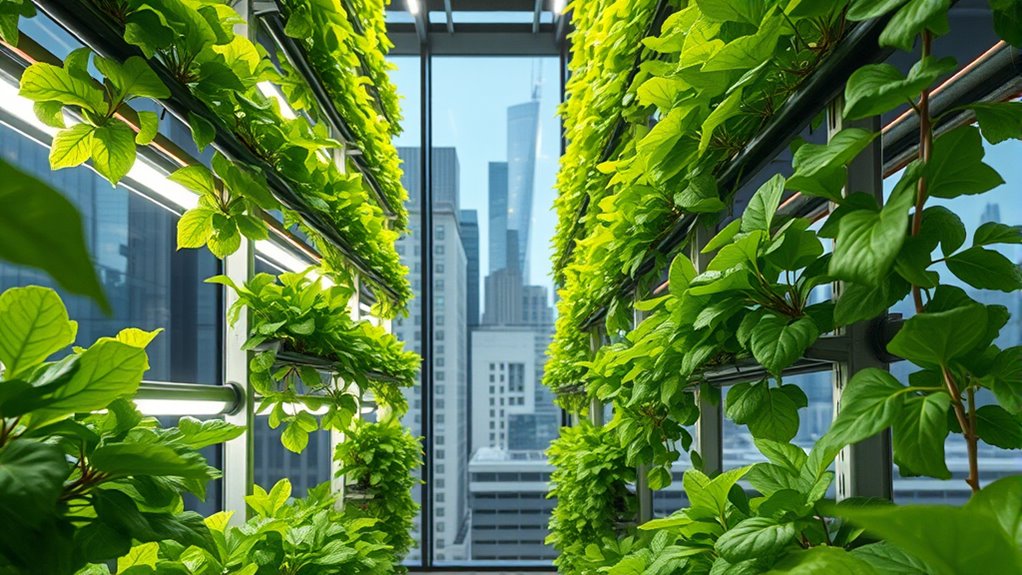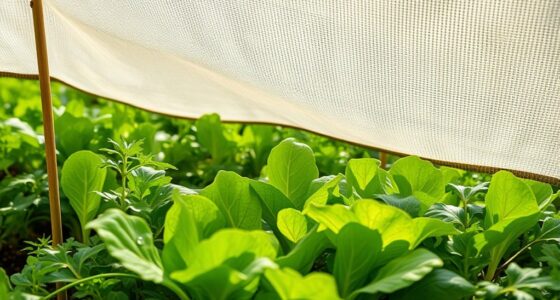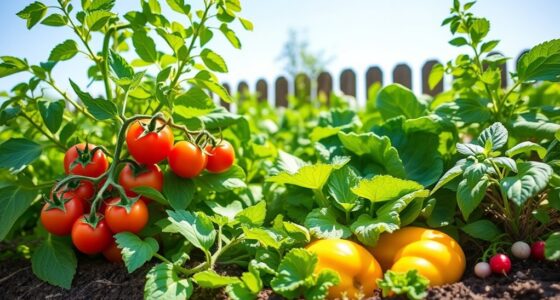Vertical farming is a space-saving solution that maximizes urban land efficiency while promoting sustainable food production. By utilizing vertical space and innovative techniques, it reduces land use significantly. It incorporates advanced irrigation systems and renewable energy, which cuts water waste and lowers carbon emissions. Plus, it's adaptable to urban planning, creating greener, self-sufficient communities. This approach not only enhances local food security but also stimulates economic growth. There's much more to explore about its benefits and potential.
Key Takeaways
- Vertical farming uses 28 times less land than conventional farming, significantly enhancing space efficiency in urban environments.
- Multi-layer systems and modular racking in vertical farms allow for flexible crop stacking, optimizing vertical space.
- Unique planter designs not only maximize growing space but also contribute to the aesthetic appeal of urban settings.
- Vertical farms can be integrated into urban planning, promoting self-sufficient communities and supporting sustainable development goals.
- Compliance with zoning regulations is essential for successful vertical farming initiatives in urban areas, ensuring legal and operational viability.
Space Efficiency in Urban Farming
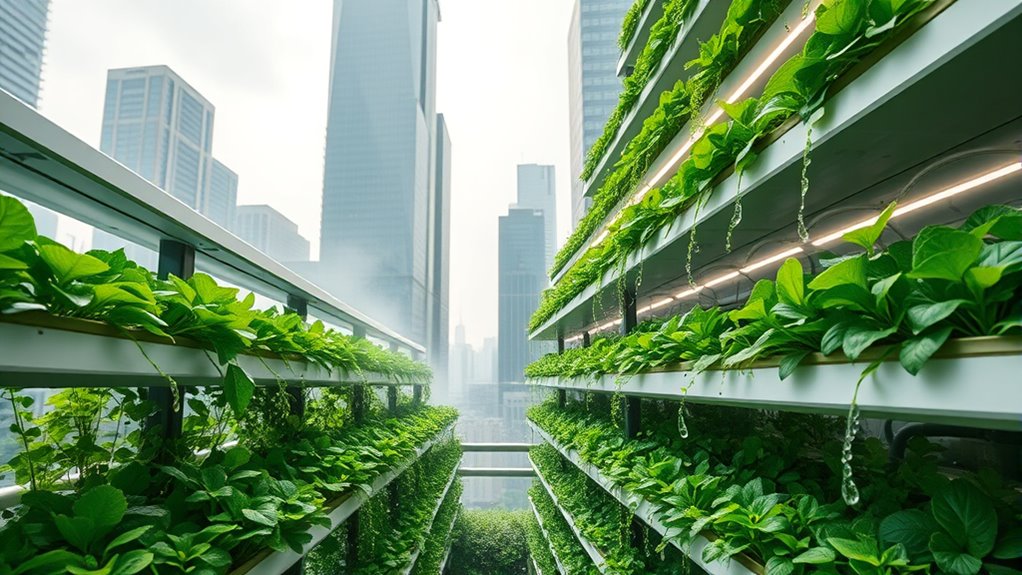
As urban areas continue to grow, maximizing space efficiency in farming becomes crucial for sustainable food production.
You can implement vertical farming techniques like multi-layer systems and modular racking to stack crops and enhance flexibility. By utilizing vertical stacking, you'll increase yield per square foot, making the most of your limited space. Additionally, incorporating unique planter designs can further optimize your vertical space while adding aesthetic value to your farming setup. Understanding zoning regulations can also help ensure that your vertical farming initiatives comply with local laws.
Controlled Environment Agriculture (CEA) empowers you to manage light, humidity, and nutrients precisely, ensuring continuous year-round production, regardless of external conditions. Consider using grow tents or containers to create tailored environments for specific crops.
Also, rooftop gardens and repurposed buildings can transform underused urban areas into productive agricultural hubs, enabling you to grow food closer to consumers while reducing food miles and boosting urban greening. Additionally, integrating solar-powered solutions can further enhance energy efficiency and sustainability in urban farming practices.
Water Conservation Techniques

Maximizing space efficiency in urban farming naturally leads to a focus on water conservation techniques. In vertical farming, efficient irrigation systems like drip irrigation and hydroponics deliver water directly to plant roots, minimizing waste.
The closed environments prevent water loss through evaporation, while advanced technologies such as fogponics and aeroponics further cut water consumption. You'll also find water recycling systems that recirculate and treat water, enhancing efficiency.
Precision watering ensures plants receive exact doses, reducing wastage. Additionally, practices like rainwater harvesting and graywater recycling can help you conserve even more.
Environmental Benefits of Vertical Farming
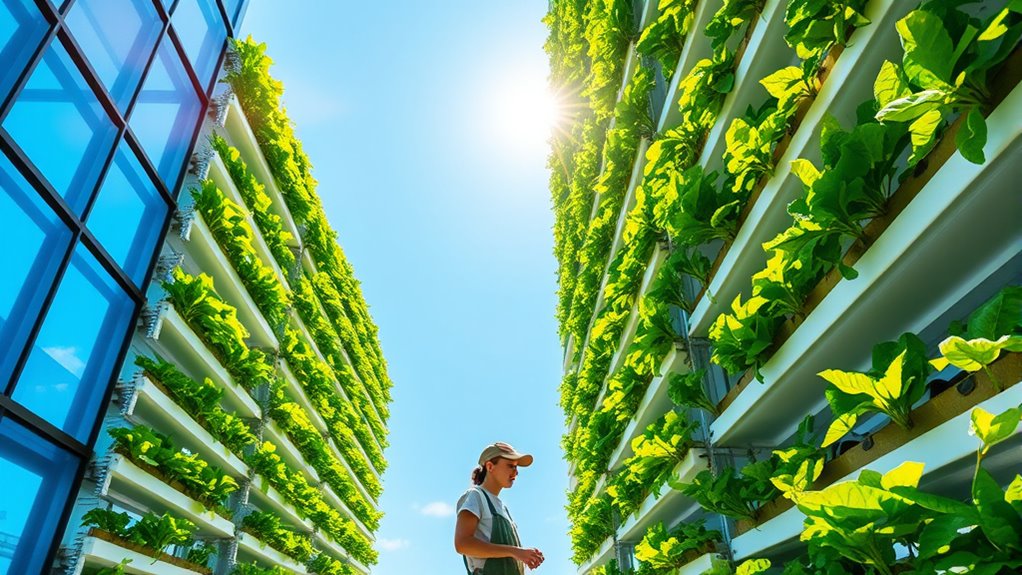
While many traditional farming methods strain the environment, vertical farming offers a sustainable alternative that significantly benefits our planet.
By utilizing about 28 times less land than conventional farming, it conserves valuable space. When powered by renewable energy, vertical farming can reduce climate change impacts six-fold. Plus, it doesn't contribute to soil degradation, helping preserve our topsoil.
You'll also notice fewer harmful chemicals, promoting healthier produce. With year-round production, vertical farming enhances local food security and reduces the need for long-distance transportation, cutting down on carbon emissions.
It also protects crops from adverse weather, ensuring resilience against climate challenges.
In short, vertical farming is a game-changer for environmental sustainability and urban food access.
Technological Innovations Driving Growth
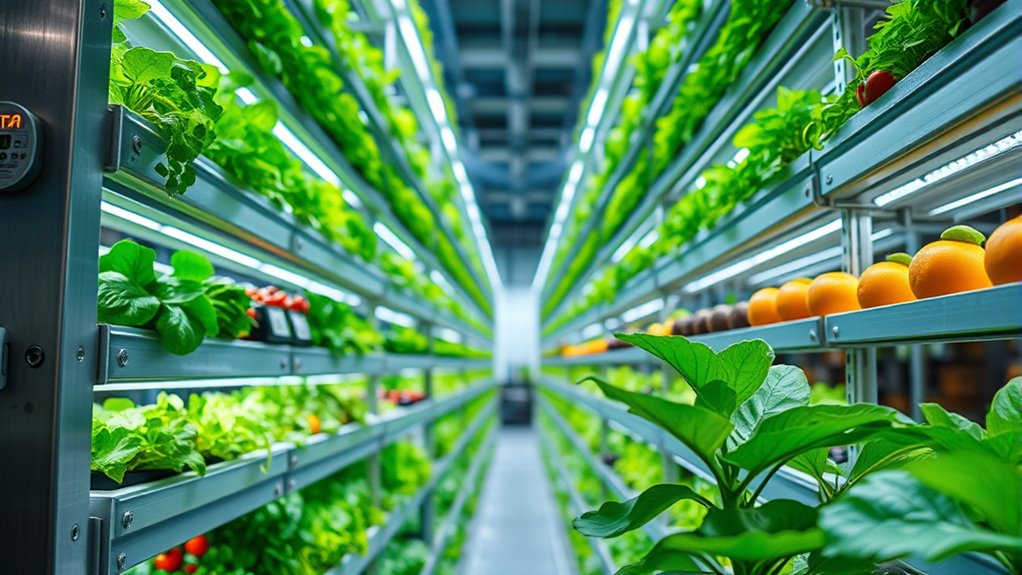
Technological innovations are revolutionizing vertical farming, making it more efficient and accessible than ever.
LED lighting enhances crop yields while slashing energy costs. Climate control systems ensure optimal temperature, humidity, and CO2 levels, creating the perfect environment for your plants.
Automated nutrient delivery systems guarantee precise nourishment, while smart IoT sensors monitor conditions in real-time.
Artificial intelligence and machine learning analyze this data to fine-tune growth conditions and anticipate potential issues.
Soilless cultivation methods like hydroponics and aeroponics maximize resource use, while modular farms offer scalability and ease of implementation.
With these advancements, you can grow fresh produce in urban spaces and contribute to a sustainable food future.
Embrace these innovations to elevate your vertical farming experience.
Economic and Social Impact on Communities

As vertical farming continues to grow, it not only transforms how we produce food but also has a significant economic and social impact on communities.
You'll notice job creation in agriculture, technology, and logistics, which boosts local economies. By offering fresh, high-quality produce, vertical farms tap into compelling market opportunities, enhancing economic growth. Additionally, nature connection fosters emotional healing and well-being, which can further enrich community interactions.
Job creation in agriculture and technology through vertical farming boosts local economies and enhances market opportunities.
They also improve food security, ensuring access to nutritious options while reducing food deserts. Community engagement flourishes as residents participate in farming, promoting education and pride. Healthier eating habits emerge with easy access to diverse produce, contributing to public health. Plus, repurposing urban spaces through vertical farms fosters greener cities and empowers local residents with skills and opportunities, strengthening social cohesion. Additionally, professional counseling can support communities in navigating the social changes that accompany new agricultural practices.
Future Potential for Sustainable Agriculture
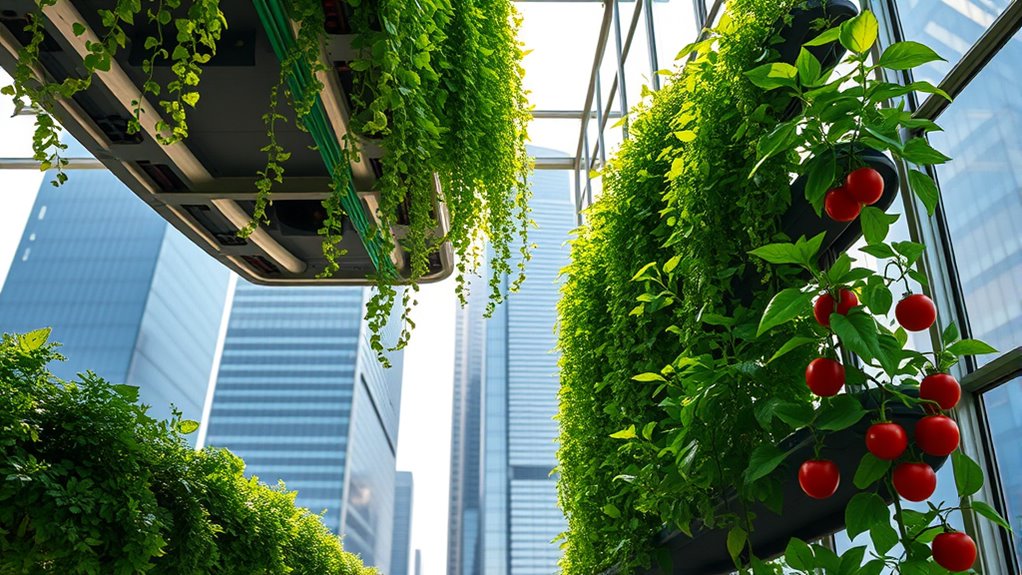
The rise of vertical farming not only reshapes local economies but also points to a promising future for sustainable agriculture.
You'll see increased automation and AI enhancing efficiency, reducing labor costs, and integrating renewable energy sources to cut carbon footprints. Advanced technologies like hydroponics and aeroponics will optimize crop growth, making fresh produce more accessible and contributing to global food security. Airless paint sprayers can be utilized in vertical farming to efficiently paint and maintain equipment and structures, further enhancing operational efficiency. In addition, nutrition plays a crucial role in ensuring that the produce grown is not only abundant but also rich in essential vitamins and minerals.
Vertical farms minimize water usage, needing up to 95% less than traditional farming. With controlled environments, you'll enjoy healthier, pesticide-free produce. Composting techniques in these systems can further enhance soil health and nutrient availability.
As these farms expand, they'll integrate into urban planning, promoting holistic land management and preserving agricultural land for biodiversity. Embracing these innovations is key to a sustainable future.
Crop Diversity and Year-Round Production
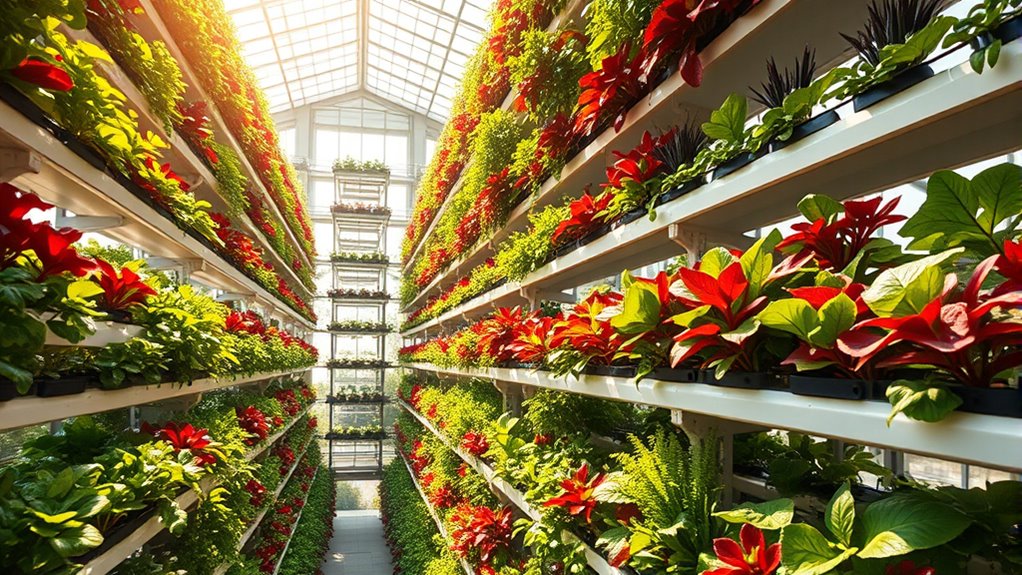
While many traditional farming methods are limited by seasonal changes, vertical farming offers the unique advantage of year-round production, allowing for a diverse array of crops to thrive.
You can enjoy enhanced nutritional value by growing various crops, including heirloom and rare varieties that preserve genetic diversity. This diversity also reduces pest and disease risks, contributing to a healthier farming environment.
With soilless techniques like hydroponics and aeroponics, you can optimize growth and yields. Urban vertical farms provide fresh, locally grown produce, minimizing transportation reliance.
Global Adoption and Food Security Solutions
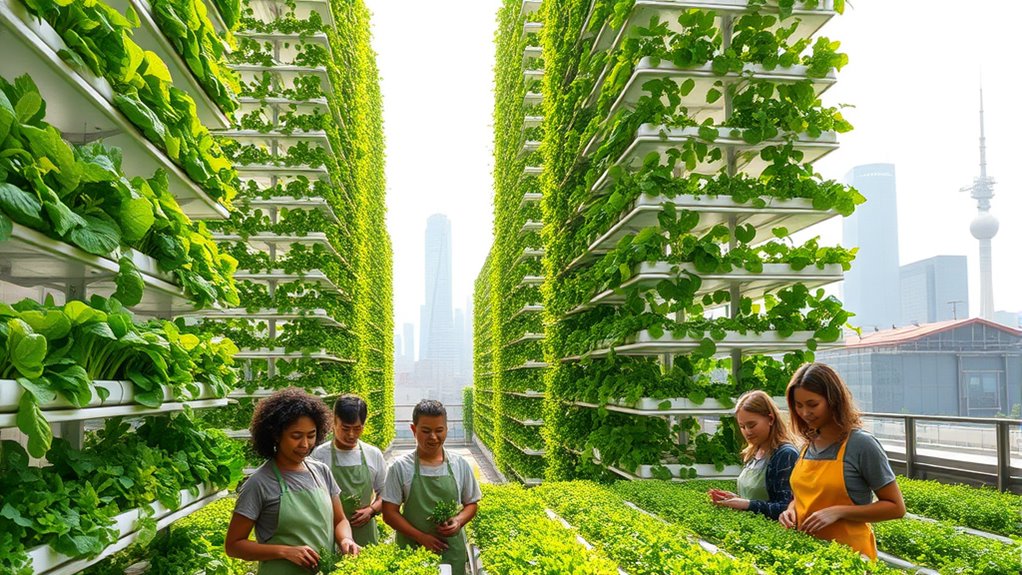
Given the increasing challenges of food security, vertical farming emerges as a vital solution that not only enhances local food production but also addresses the complexities of urbanization.
The global vertical farming market is on track to expand significantly, projected to reach USD 13.7 billion by 2029. Regions like North America and Asia Pacific lead this growth, driven by urban density and environmental concerns. Heat pumps can be integrated into vertical farming systems to optimize energy efficiency and reduce operational costs.
By providing fresh produce locally, vertical farming reduces reliance on lengthy supply chains, improves accessibility in food deserts, and bolsters public health.
Additionally, it conserves water and land while ensuring consistent yields, regardless of climate. By integrating these farms into urban planning, you can help create more resilient, self-sufficient communities. Furthermore, implementing energy efficiency strategies in vertical farms can further reduce operational costs and environmental impact.
Frequently Asked Questions
What Types of Crops Are Best Suited for Vertical Farming?
When considering what types of crops are best suited for vertical farming, focus on compact growth habits and fast growth rates.
Leafy greens like lettuce and spinach thrive in these systems. Herbs such as basil and cilantro are also great choices due to their high market demand.
Don't forget microgreens for their quick turnaround. Additionally, some fruiting plants, like strawberries, can adapt well if conditions are right.
Ensure you meet their specific environmental needs for optimal growth.
How Does Vertical Farming Impact Local Ecosystems?
You might think vertical farming could harm local ecosystems, but it actually benefits them.
By using less land for agriculture, it helps prevent deforestation and preserves natural habitats. This approach minimizes chemical runoff, protecting local water sources and supporting biodiversity.
Plus, by integrating farms into urban areas, you reduce the pressure on rural land, allowing ecosystems to regenerate.
What Are the Startup Costs for Establishing a Vertical Farm?
When you're considering establishing a vertical farm, startup costs can vary significantly.
You might need between $50,000 and $500,000, depending on your scale and technology choices. For a small operation, expect around $50,000 to $100,000. Larger farms can push costs over $500,000.
Key expenses include land leasing, equipment, hydroponic systems, and renovation.
Starting small, using second-hand equipment, and seeking grants can help you manage these initial investments more effectively.
How Do Vertical Farms Handle Pest Management Without Pesticides?
You'll find that vertical farms effectively manage pests without pesticides through a combination of methods.
They maintain controlled environments, which deter pests by regulating temperature and humidity. Soilless growing systems like hydroponics limit pest habitats.
Additionally, they often use biological pest control, introducing natural predators to keep pest populations in check.
This holistic approach not only protects crops but also supports sustainable practices, making it an innovative solution in modern agriculture.
What Is the Lifespan of Vertical Farming Systems?
Did you know that steel structures in vertical farming systems can last around 25 years? The lifespan of these systems varies mainly based on the components used, like hydroponics or aeroponics.
Regular maintenance plays a crucial role in extending their longevity. Environmental conditions also help; controlled environments reduce wear and tear.
Moreover, advancements in technology continuously improve efficiency and durability, ensuring your vertical farming system can thrive for years to come.
Conclusion
As you gaze out at the skyline, you might catch a glimpse of a vertical farm nestled between towering buildings. It's a perfect coincidence—nature and urban life harmonizing. This innovative solution not only saves space but also conserves water and boosts local economies. With technological advancements and diverse crops thriving year-round, vertical farming isn't just a trend; it's a glimpse into a sustainable future. Together, you and your community can reap the benefits of this green revolution.

